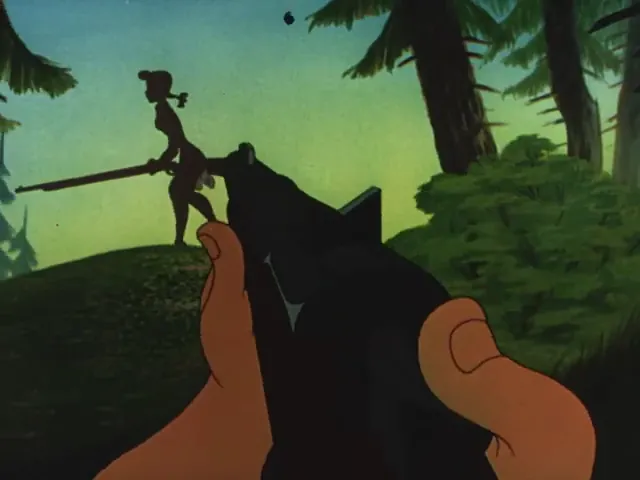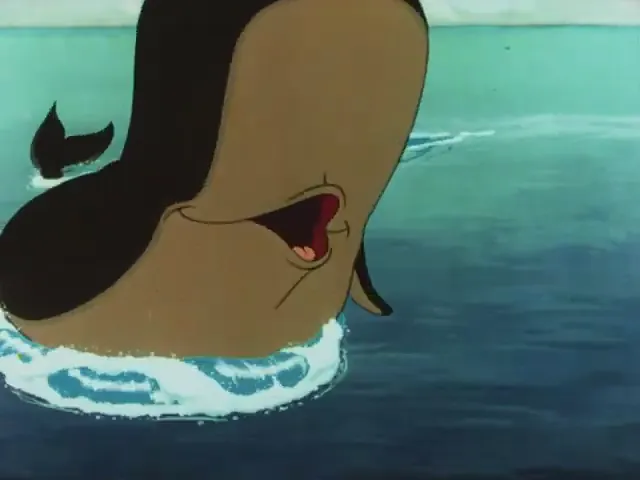🎯 Quick Overview
Trailer
- Director: Robert Cormack, Hamilton Luske, Clyde Geronimi, Joshua Meador, Jack Kinney, Bill Roberts, Harold Young
- Genre: Animated, Comedy, Family, Fantasy, Musical, Adventure
- Release year: 1946
- Runtime (length): 1h 15min
- IMDb rating: 6.1/10 (5.2K votes)
- Rotten Tomatoes: 62%
😅 Plot Summary – Badly Explained
Anthropomorphic hats fall in love and end up as horse accessories while a whale sings opera, gets harpooned, and goes to heaven.
🍿 Make Mine Music: Detailed Plot Synopsis
An Anthology of Musical Animation
Released in 1946 during Walt Disney Productions’ “package feature” era, ‘Make Mine Music’ is an anthology film consisting of ten animated segments set to various styles of music popular at the time. This film followed the experimental format of ‘Fantasia’ but focused on contemporary popular, jazz, swing, and classical music, rather than strictly classical pieces. Each segment is musically driven, featuring a range of animation styles and narratives from character-focused stories to abstract interpretations of music. The collection showcases the studio’s diverse talent during a transitional period following World War II.

Peter and the Wolf
One of the most well-known segments, this is an adaptation of Sergei Prokofiev’s classic musical fairy tale. Narrated by Sterling Holloway (later the voice of Winnie the Pooh), the story follows young Peter as he sets out to capture a wolf with the help of his animal friends: a bird named Sasha, a duck named Sonia, and a cat named Ivan. The segment introduces Peter’s grandfather who warns him of the dangers of the forest, only for Peter to sneak out. It faithfully uses Prokofiev’s score, with different instruments representing the characters, bringing the classic story to vibrant animated life.

Casey at the Bat
Based on Ernest Lawrence Thayer’s famous 1888 poem, this segment is a comedic adaptation narrated by Jerry Colonna. It tells the story of the Mudville baseball team, who are losing in the final inning, with their hopes resting on their arrogant star player, Casey. The animation highlights the slapstick and dramatic moments of the poem, building tension as Casey comes to bat. The segment captures the era’s style and humor, focusing on the dramatic turn of events on the baseball diamond.

The Whale Who Wanted to Sing at the Met
This segment tells the poignant story of Willie, a sperm whale with an extraordinary operatic singing voice. Willie dreams of performing opera on stage, specifically at the Metropolitan Opera House (the “Met”). His incredible vocal talent causes confusion and speculation among humans, particularly with impresario Professor Tetti Tatti. The story follows Willie’s aspirations and the dramatic misunderstanding that arises from his unique ability.

Johnnie Fedora and Alice Bluebonnet
Sung by The Andrews Sisters, this is a charming love story between two anthropomorphic hats: a fedora named Johnnie and a bonnet named Alice. They meet and fall in love while displayed in a department store window. Their romance is interrupted when Alice is sold. Johnnie is later sold himself and embarks on a quest to find his lost love, encountering various owners and adventures along the way.
Other Notable Segments
Other segments in the film include ‘The Martins and the Coys,’ a rustic ballad about feuding families (often removed from modern versions); ‘Blue Bayou,’ a serene tone poem set to music; ‘All the Cats Join In,’ a lively jazz interlude featuring teenage dancers animated as if being drawn by a pencil; ‘Without You,’ a melancholic ballad illustrated with impressionistic visuals; ‘Two Silhouettes,’ featuring rotoscoped ballet dancers performing in silhouette; and ‘After You’ve Gone,’ an abstract jazz piece featuring anthropomorphic musical instruments.
⚠️ Spoilers and Ending Explained
🎬 Cast & Characters
- Willie the Whale (Nelson Eddy): A talented whale whose dream of singing opera at the Metropolitan Opera House is tragically misunderstood.
- Peter (Sterling Holloway): A brave young boy who embarks on an adventure to capture a wolf with the help of his animal friends.
- Casey (Jerry Colonna): Mudville’s legendary baseball slugger whose overconfidence leads to a disappointing strikeout.
- Johnnie Fedora (Andrews Sisters): A fedora hat that falls deeply in love with a bonnet and searches tirelessly after they are separated.
- Alice Bluebonnet (Andrews Sisters): A charming bonnet hat who shares a sweet romance with a fedora before a chance reunion brings them back together.
- The Wolf (N/A): A menacing predator in the forest who poses a threat to Peter and his animal companions.
- Professor Tetti Tatti (Nelson Eddy): A renowned but misguided impresario convinced that Willie’s singing is caused by a swallowed opera singer.
💬 Memorable Quotes
- Narrator: “Peter, don’t just stand that way! And don’t stand that way either.” – Said by Sterling Holloway, the narrator, giving humorous direction to the animated Peter when he faces the wolf.
- Narrator (Casey at the Bat): “But there is no joy in Mudville—mighty Casey has struck out.” – The iconic final line recited by Jerry Colonna, narrating the tragic outcome of Casey’s turn at bat.
- Narrator (Willie the Whale): “Who ever heard of an operatic whale?” – Asked rhetorically by Nelson Eddy, introducing the fantastical premise of Willie, a whale who can sing opera.
- Singers: “Johnnie Fedora met Alice Bluebonnet…” – The opening lyric sung by the Andrews Sisters, introducing the two hats who fall in love.
💰Box Office
- Budget: Unknown
- Domestic Gross: Unknown
- Worldwide Gross: Unknown
💥 Make Mine Music Reviews
Personal Review
Okay, so I finally watched ‘Make Mine Music,’ and wow, it’s a wild ride! It’s totally different from typical Disney movies because it’s a bunch of short cartoons set to music. Some parts are really sweet and stuck with me, like the little love story between the hats, ‘Johnny Fedora and Alice Bluebonnet.’ I honestly didn’t expect to care about hats that much, but it got me right in the feels when they were separated! And the ‘Peter and the Wolf’ segment is a classic for a reason – Sterling Holloway’s narration is just perfect. Other parts were just pure fun, especially the jazz sequences with Benny Goodman. The ‘All the Cats Join In’ segment with the drawing pencil feels so creative and energetic, like you’re seeing the animation come to life! The ‘Whale Who Wanted to Sing at the Met’ was also unforgettable, even if the ending was a little… abrupt. Yeah, some segments didn’t totally click with me, and it definitely feels like a collection rather than one movie. But overall, I’m really glad I watched it. It’s a fascinating look at a different side of Disney animation and music from that era. It made me appreciate the variety and the sheer talent involved, even if it’s not as famous as ‘Fantasia.’
- Who would enjoy:
- “Fans of classic Disney animation”
- “Viewers interested in Disney’s ‘package films’ era (1940s)”
- “Those who enjoy anthology films and diverse animation styles”
- “Fans of 1940s music (jazz, swing, pop, light classical)”
- “Families looking for older animated content (with consideration for warnings)”
- Content warnings ⚠:
- “Cartoon violence (specifically in the removed ‘Martins and Coys’ segment, and mild peril in ‘Peter and the Wolf’)”
- “Potentially sad or downbeat ending (‘The Whale Who Wanted to Sing at the Met’)”
- “Brief suggestive content (‘All the Cats Join In’ includes a character shown showering)”
- “Dated stereotypes (particularly in ‘The Martins and Coys’ and character designs)”
- “Uneven tone and pacing due to anthology format”
Professional Reviews
- Critic Review: “This collection of animated shorts feels like Disney’s attempt at a ‘pop’ Fantasia for the 1940s. While uneven, it boasts some fantastic sequences like the energetic Benny Goodman jazz numbers and the unforgettable finale about the singing whale. The animation quality is generally high, making it a bright and amusing piece of light entertainment perfectly suited for its era, even if some segments haven’t aged as gracefully.
- Critic Review: “A mixed bag of musical shorts that varies wildly in quality. Highlights include the well-executed ‘Peter and the Wolf’ and the charming ‘Whale Who Wanted to Sing at the Met’. However, some segments feel like filler or are simply bland. It lacks the cohesive artistic vision of ‘Fantasia’ and works better when viewed as individual pieces rather than a complete feature, though its historical significance for Disney fans is undeniable.
- Critic Review: “While showcasing impressive animation craftsmanship for its time, ‘Make Mine Music’ is ultimately a frustratingly uneven experience. Too many segments are dull, overly sentimental, or just plain awful. The attempts at ‘interpretive’ animation fall flat, and even the more story-driven shorts like ‘Casey at the Bat’ feel rushed. It’s a low point in Disney history that’s probably best skipped unless you’re a completist.
Audience Reactions
Viewers were delighted by standout segments like ‘Peter and the Wolf’ and ‘The Whale Who Wanted to Sing at the Met’.: Many appreciated the variety of music and animation styles, as well as the historical context it provides.
The Benny Goodman jazz sequences were frequently cited as energetic and fun favorites.: There was a lot of discussion about the film’s unevenness, with some segments being loved and others found boring or skippable.
The emotional depth in ‘Johnny Fedora and Alice Bluebonnet’ and ‘The Whale Who Wanted to Sing’ resonated with many.: The removal of the ‘Martins and Coys’ segment from later versions was a common point of contention and disappointment among fans.
Overall Consensus: A historically significant, albeit uneven, Disney anthology film praised for its diverse music and animation styles, with specific segments (‘Peter and the Wolf,’ ‘The Whale Who Wanted to Sing,’ the jazz numbers, ‘Johnny Fedora and Alice Bluebonnet’) being particularly beloved by audiences, despite the collection’s overall inconsistency.
Awards
🛠️ Behind the Scenes
- “The ‘Blue Bayou’ segment uses animation footage originally created for a sequence in Fantasia (1940) that was meant to accompany Claude Debussy’s ‘Clair de Lune’ but was cut.”
- “The film was one of several ‘package features’ produced by Disney during and immediately after World War II, a period when the studio was financially strained and fewer animators were available for full-length features.”
- “The segment ‘The Martins and the Coys’ was removed from later US home video releases of the film due to concerns over the comic depiction of gun violence.”
- “The ‘All the Cats Join In’ segment features an animated pencil that visibly draws the action and characters as the music plays.”
- “The ending of the ‘Whale Who Wanted to Sing at the Met’ segment is unusually somber for a classic Disney film, depicting the protagonist’s death.”
🖥️ How to Watch Make Mine Music?
Finding ‘Make Mine Music’ can be tricky as it is often not available on major streaming platforms like Disney+ in its original full form due to content alterations over the years. However, you can typically find it available for digital purchase or rental on platforms such as Amazon Prime Video, Apple TV, and other major digital movie retailers. Check your preferred service for current availability and pricing.

🎥 Similar Movies
If you enjoyed Make Mine Music, you might like these similar films:
- Fantasia (1940): The most direct predecessor and thematic kin, using animation set to diverse pieces of music, albeit primarily classical.
- Melody Time (1948): Another Disney ‘package feature’ from the same era, also consisting of animated shorts set to popular and folk music.
- Fun and Fancy Free (1947): A compilation film from the same post-WWII period at Disney, blending animated shorts and live-action segments with musical elements.
- Allegro Non Troppo (1976): An Italian animated anthology film that directly parodies and pays homage to Fantasia, setting classical music to a variety of imaginative and often darkly comedic animations.
- Yellow Submarine (1968): An animated film heavily driven by music (The Beatles’ songs), featuring distinct, experimental animation styles and a journey composed of various visual and musical sequences.
🛒 Make Mine Music Related Products
- Walt Disney Animation Studios Short Films Collection: A collection featuring beloved animated shorts from the Disney vault, showcasing different styles and eras of Disney animation.
- Peter and the Wolf (Picture Book Adaptation): A beautifully illustrated children’s book retelling the classic Prokofiev story, bringing the characters from the animated segment to life on the page.
- Classic 1940s Swing & Jazz Music Compilation: An album featuring iconic big band, swing, and jazz tracks from the 1940s, including artists featured in the movie.
- The Art of Walt Disney: From Mickey Mouse to the Magic Kingdoms: A comprehensive art book detailing the history of Disney animation, including the ‘package film’ era and the distinct animation styles used in films like ‘Make Mine Music’.
🎧 Soundtrack
Make Mine Music features a captivating soundtrack that enhances the movie’s atmosphere and emotional impact. Here are some notable tracks:
- “The Martins and the Coys” – performed by Ted Weems and his Orchestra, The King’s Men
- “Blue Bayou” – performed by The Ken Darby Chorus
- “All the Cats Join In” – performed by Benny Goodman and his Orchestra, The Pied Pipers
- “Without You” – performed by Andy Russell
- “Casey at the Bat” – performed by Jerry Colonna
- “Two Silhouettes” – performed by Dinah Shore
- “Peter and the Wolf” – performed by Sterling Holloway (Narrator), Serge Prokofiev (Composer)
- “After You’ve Gone” – performed by Benny Goodman Quartet
- “Johnny Fedora and Alice Bluebonnet” – performed by The Andrews Sisters
- “The Whale Who Wanted to Sing at the Met” – performed by Nelson Eddy
You can find the complete soundtrack on Amazon Music and Apple Music.
🤨 FAQ
Make Mine Music is famously one of the few Disney animated features not consistently available on the Disney+ streaming service, particularly in its original, unaltered form, often due to the removal of the ‘Martins and Coys’ segment in modern releases. Availability can vary by region, but generally, it requires purchasing or renting digitally or on physical media.
The ‘Martins and Coys’ segment, which depicted a violent feud between two hillbilly families with comic gunplay and eventual reconciliation followed by domestic fighting, was removed from many modern releases (including the US VHS and DVD) due to concerns about the portrayal of cartoon violence and potential dated stereotypes. The uncut version is often only available on older releases or in specific international markets.
The original theatrical release of Make Mine Music contained ten distinct animated segments. However, due to the removal of ‘The Martins and the Coys’ from many home video releases, some versions of the film contain only nine segments.
Yes, Make Mine Music follows a similar anthology format to Fantasia, presenting a series of animated segments set to music. However, while Fantasia primarily uses classical music and often abstract visuals, Make Mine Music features a wider variety of music genres popular in the 1940s, including jazz, swing, pop ballads, and a classical piece (‘Peter and the Wolf’), and generally relies more on narrative storytelling within the segments.
The ‘Peter and the Wolf’ segment in Make Mine Music was narrated by Sterling Holloway, who is widely recognized for his distinctive voice work for Disney characters such as Winnie the Pooh, Kaa in ‘The Jungle Book,’ and the Stork in ‘Dumbo.’
🔥 Bonus Content
Disney Censorship: “The Martins and The Coys” from Make Mine Music (1946) from Norwegian DVD
This movie actually had a whole section removed in later releases! It’s really interesting to see the ‘Martins and the Coys’ segment that Disney decided to cut and learn about its censorship history.
Clair de Lune
Ever wonder where the ‘Blue Bayou’ segment came from? Turns out it was a beautiful piece originally planned for Fantasia! It’s cool how they repurposed this animation.
MAKE MINE MUSIC ft. Jamie Loftus (Drunk Disney #44)
Want to hear some funny folks chat about the different parts of ‘Make Mine Music’ and share their honest thoughts? This review adds a fun, casual take on the movie’s various segments.
✨ Rate
There are no reviews yet. Be the first one to write one.





